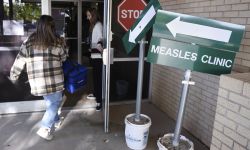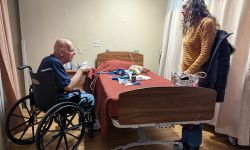Why did coronavirus spread so fast in Michigan compared to neighbors?
In three weeks, coronavirus has swamped Michigan, making it the fourth hardest-hit state in the nation, while the outbreak has grown far slower in neighboring states.
The virus came to the Great Lakes states around the same time, with Michigan confirming its first two cases on March 10, when Illinois had 19 cases and Ohio had three.
Now, the numbers are vastly different: As of Tuesday, Michigan had 7,615 cases, Illinois had just under 6,000, and Ohio, Indiana and Wisconsin all have less than 2,200.
The wide difference raises questions about how the states could follow such different paths. Epidemiologists warn that it’s too early in the crisis to make conclusions, but some experts wonder if Michigan’s caseload would be different if public officials moved faster in the early days of the outbreak.
“They’ve all done the same thing,” said David Hutton, a health planning and policy professor at the University of Michigan.
But timing makes a big impact, he added: “Days can make a difference.”
As with states across the nation, Michigan closed schools, shut bars and restaurants and limited large gatherings in mid-March and ultimately issued a “stay at home” order.
On March 20, Illinois Gov. J.B. Pritzker ordered state residents to “stay at home” the following day. At the time, the state had 585 confirmed cases of COVID-19 while Michigan had 549.
- The latest: Michigan coronavirus map, locations, updated COVID-19 news
- What Michigan’s coronavirus stay-at-home order means for residents
- What jobs are exempt from Michigan coronavirus lockdown? You may be surprised.
Asked that day if Michigan would follow suit, Gov. Gretchen Whitmer said “we’re not there yet.” Over the next two days, Michigan’s business community lobbied the governor against a broad order they said would hurt the economy.
She issued the order March 23 and like those in Ohio and Indiana, it went into effect the next day.
But by then, Michigan had more than three times the number of cases than Ohio, 1,535 to 567, while Indiana had 365. Wisconsin’s stay at home order went into effect the next day, when it had 585 cases.
Hutton said that in retrospect “it would have been more prudent” to enact the measure “a few days earlier.”
Tiffany Brown, a spokeswoman for Whitmer, said the governor has moved aggressively, activating the "State Emergency Operations Center to closely monitor the situation and make sure the state was prepared to respond before Michigan even had its first case of COVID-19."
"Since that time she has taken numerous proactive actions and signed executive orders, including 'Stay Home, Stay Safe' to mitigate the spread," Brown said in a statement released Tuesday night.
Hindsight is a huge benefit, of course, and Hutton acknowledged numerous other factors could be at play including simple “bad luck.”
Michigan could have been hit harder because the virus may have already been in the community for days or weeks before the symptoms or testing.
Among the possibilities Hutton and others have mentioned for the rapid spread in Michigan:
- Detroit Metropolitan Airport, which has a large international hub and flights to Wuhan, China, where the outbreak originated in December and its airport remained open until Jan. 23.
- Supply lines between Detroit automakers and Wuhan, a major auto hub and home to five car manufacturers including Dongfeng Motor, one of the biggest in China. General Motors has 15 assembly plants in China with its partners, while Ford has six and Fiat Chrysler has two.
- Ties between automakers, particularly FCA, and Italy, which has more than 77,000 cases and 12,000 deaths.
- Michigan's March 10 presidential primary and big campaign rallies leading up to it, including one that drew 6,000 in Detroit for Bernie Sanders on March 6. In contrast, Ohio cancelled its March 17 primary.
Michigan, as with other states, could have benefited from an earlier crackdown on gatherings and social contact, said Dr. Vikas Parekh, associate chief clinical officer for the University of Michigan Medicine’s adult hospitals.
UM researchers have concluded that strict adherence to social distancing guidelines can cut hospital admissions by 65 percent.
“We know that, the earlier that you implement social distancing measures in the life of an epidemic, the more rapidly you can halt the rise and the quicker that you can get control so that is true for Michigan as it was true for every country that has had a coronavirus,” Parekh said.
Without social distancing, the infection rate doubles every three days, he said.
That rate slows to every eight days if most people social distance — a huge difference for the hospitals tasked with caring for the ill; at UM, it could mean the difference between having nearly 6,000 patients on May 4 or nearly 3,200 on May 16.
Experts said it could take extensive research to know how the virus spread and the lack of early testing makes that difficult.
“We’ll have a much better idea in the coming days and weeks, though there is certainly reason to hope that states which rigorously enforce social distancing will help flatten the peak of infections,” said Christopher Adolph, associate professor of political science at the University of Washington.
He wrote a recent paper noting that Republican governors had enacted restrictions a few days later than Democratic governors.
At the time Whitmer issued her order, only six other states had done the same, including the then harder hit states of California, New York and New Jersey.
Ohio Gov. Mike DeWine issued his order the day before Whitmer but it went into effect the same day.
DeWine, a Republican, has been ahead of most of his regional peers, three of whom are Democrats: Whitmer, Pritzker and Wisconsin Gov. Tony Evers.
Gov. Eric Holcomb of Indiana is a Republican and is the only one of the five who has typically enacted orders later than the others. He has only recommended that people not gather in groups of 50 or more and his K-12 schools closure was several days after the other states.

See what new members are saying about why they donated to Bridge Michigan:
- “In order for this information to be accurate and unbiased it must be underwritten by its readers, not by special interests.” - Larry S.
- “Not many other media sources report on the topics Bridge does.” - Susan B.
- “Your journalism is outstanding and rare these days.” - Mark S.
If you want to ensure the future of nonpartisan, nonprofit Michigan journalism, please become a member today. You, too, will be asked why you donated and maybe we'll feature your quote next time!








